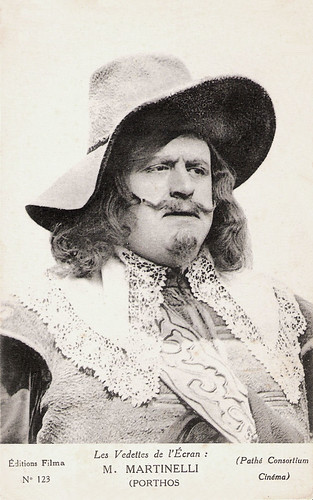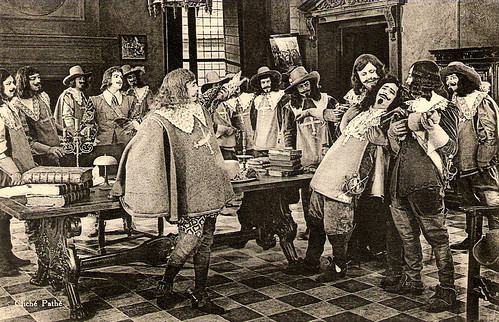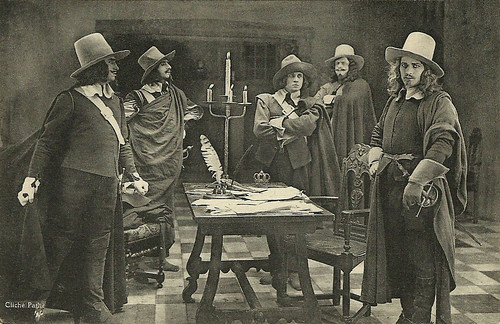Charles Martinelli (1882-1954) was a French actor, who became famous for his interpretation of Porthos in Les trois mousquetaires / The Three Musketeers (1921).

French postcard by Cinémagazine-Edition, no. 44. Photo: Pathé Consortium Cinéma. Charles Martinelli as Porthos in Les Trois Mousquetaires / The Three Musketeers (Henri Diamant-Berger, 1921) or maybe, the sequel Vingt ans après / Twenty Years Later (Henri Diamant-Berger, 1922).

French postcard. Photo: Pathé. A scene from Les trois mousquetaires (Henri Diamant-Berger, 1921), with from left to right: Aimé Simon-Girard as D'Artagnan, Charles Martinelli as Porthos, Pierre de Guingand as Aramis, and Henri Rollan as Athos.

French postcard by Editions Filma, no. 123. Photo: Pathé Consortium Cinéma. Charles Martinelli as Porthos.
Charles Martinelli, whose real name was Charles Martinet, was born in Paris in 1882. He started out as an actor and singer, performing Panurge by Massenet and playing in 'Boubouroche' by Georges Courteline. For ten years, he was the Chair of the Union des Artistes Français. According to IMDb, his first film part was in Le petit poucet / Tom Thumb (Robert Boudrioz, 1920), produced by Abel Gance. The year 1920 might be a mistake, though, as the French magazine Cinéa of July 1922 announced that Martinelli would start to play the ogre while Christiane Delval played Tom Thumb. It also remarked that Martinelli was already known from his part of Porthos in Les trois mousquetaires (1921).
Indeed, it seems that Martinelli had his real breakthrough with the French historical adventure film Les trois mousquetaires / The Three Musketeers (1921), directed by Henri Diamant-Berger and adapted from Alexandre Dumas père’s classic novel, published in 1844. The script by Auguste Macquet follows the classic novel by Alexandre Dumas père very faithfully. Martinelli played the good-hearted, rotund Porthos, opposite Aimé Simon-Girard as D’Artagnan, Henri Rollan as Athos, Pierre de Guingand as Aramis, Edouard de Max as Richelieu, Pierrette Madd as Constance, Claude Merelle as Mylady De Winter, and Armand Bernard as Planchet.
Les trois mousquetaires had the gigantic budget of 2.5 million French francs. It has wonderful performances, great-looking sets (partly filmed on locations as the Chenonceau castle, Chartres and the Pérouges citadel), and authentic recreations of 17th-century costumes. Responsible for sets and costumes was the French reputed architect and designer Robert Mallet-Stevens. The film was divided into one-hour chapters, designed to be released as a serial in consecutive weeks over three months. This silent super-serial was produced by Pathé Frères.
Parallel to Diamant-Berger’s version, Fred Niblo shot a rival version in the US starring Douglas Fairbanks as D’Artagnan, The Three Musketeers (Fred Niblo, 1921). Though entertaining, it was much more loosely adapted. The success of Les trois mousquetaires was aided by an arrangement with United Artists that kept Fairbanks’s The Three Musketeers from being distributed in France and much of Europe. All copies of the 1921 version were thought to be destroyed by the Nazis during the Second World War, but in 1995 a print was rediscovered, and remastered into a new version. It was already the second adaptation of the famous adventure novel by Alexandre Dumas père, after a first adaptation in 1913, but it wouldn’t be the last either.
In 1933 Henri Diamant-Berger made a new, sound version of Les trois mousquetaires. While Thomy Bourdelle now played Porthos, Aimé Simon-Girard starred again as D'Artagnan, Henri Rollan returned as Athos, and Henry Baudin also reprised his role as Le comte de Rochefort. The success of the 1921 version pushed Pathé to film Dumas’ sequel, 'Vingt ans après', as well, which was released in 1922 and was again directed by Diamant-Berger. Martinelli remained as Porthos, and Rolland, Guingand and Bernard returned, but D’Artagnan was played by Jean Yonnel.

French postcard by M. Le Deley, Paris. Photo: Pathé Consortium Cinéma. Publicity still for Les Trois Mousquetaires / The Three Musketeers (Henri Diamant Berger, 1921). The four musketeers were played by Aimé Simon-Girard (D'Artagnan), Henri Rollan (Athos), Pierre de Guingand (Aramis) and Charles Martinelli (Porthos).

French postcard by M. Le Deley, Paris. Photo: Pathé Consortium Cinéma. Publicity still for Les Trois Mousquetaires / The Three Musketeers (Henri Diamant Berger, 1921).
Charles Martinelli remained attached to Diamant-Berger’s films in 1921-1923, which were mostly comedies. He had the lead in the adaptation of the play Boubouroche (1921). Before, he had already starred in the stage play. He also acted in Diamant-Berger’s Le mauvais garçon (1923), Gonzague (1923), Jim Bougne, boxeur (1923), L’accordeur (1923) and L’affaire de la rue de Lourcine (1923), all starring Maurice Chevalier, and Le roi de la vitesse (1923), starring Pierre de Guingand.
In those films, several of the actors of Les trois mousquetaires and Vingt ans après returned, including Pierrette Madd, Marguerite Moreno and Louis Préfils. They were joined by popular vaudeville comedians like Georges Milton and Florelle, who started their film careers here. Martinelli then did three comedies with Robert Saidreau: Ma tante d’Honfleur (1923), A la gare (1923, released 1925) and Le fil à la patte (1923), all with Armand Bernard.
In 1924, Martinelli played the mad scientist in the classic Paris qui dort (René Clair, 1924). In this madcap Science Fiction film, all the Parisians are in a state of Sleeping Beauty-like sleep. A few odd outsiders are awake, including the man on the Eiffel Tower, played by Henri Rollan, and a pilot (Albert Préjean) and his passengers. Préjean had started his career in Diamant-Berger’s Les trois mousquetaires and had become a regular in his comedies as well. Paris qui dort was also produced by Henri Diamant-Berger’s company, Films Diamant. After that, Martinelli did one last film in the silent era, playing Farigoule in La Tournée Farigoule (Marcel Manchez, 1926), with Madeleine Guitty and Jane Pierson.
In the sound era, Martinelli played in three films of the 1930s. He was the head of police in G.W. Pabst’s Don Quichotte (1932, released 1933), starring Feodor Chaliapin as Don Quichotte and Dorville as Sancho Panza. He played the emperor in the Franco-German coproduction Tambour battant (André Becler, Arthur Robison, 1933), starring Georges Rigaud, Josseline Gaël and Françoise Rosay. His last part was in the comedy Un fichu métier (Pierre-Jean Ducis, 1938), starring Lucien Baroux.
Charles Martinelli died in Paris in 1954. Since 1908 he was married to Germaine Jobert,who was a highly acclaimed concert singer during the interbellum years. Their son, Jean Martinelli, was born in 1909. For 21 years, he was a sociétaire of the Comédie Française, and afterwards he had an excellent career in private theatres, film and television. He died in 1983.

French postcard. Photo: Pathé. Publicity still for Vingt ans après / The Return of the Musketeers (Henri Diamant-Berger, 1922). Collection: Didier Hanson. The four musketeers were played by Jean Yonnel (D'Artagnan), Henri Rollan (Athos), Pierre de Guingand (Aramis) and Charles Martinelli (Porthos).

French postcard. Photo: Pathé. Publicity still for Vingt ans après / The Return of the Musketeers (Henri Diamant-Berger, 1922). Collection: Didier Hanson.
Sources: Cineressources (French), Wikipedia (French) and IMDb.
This post was last updated on 2 June 2025.

French postcard by Cinémagazine-Edition, no. 44. Photo: Pathé Consortium Cinéma. Charles Martinelli as Porthos in Les Trois Mousquetaires / The Three Musketeers (Henri Diamant-Berger, 1921) or maybe, the sequel Vingt ans après / Twenty Years Later (Henri Diamant-Berger, 1922).

French postcard. Photo: Pathé. A scene from Les trois mousquetaires (Henri Diamant-Berger, 1921), with from left to right: Aimé Simon-Girard as D'Artagnan, Charles Martinelli as Porthos, Pierre de Guingand as Aramis, and Henri Rollan as Athos.

French postcard by Editions Filma, no. 123. Photo: Pathé Consortium Cinéma. Charles Martinelli as Porthos.
Silent super-serial
Charles Martinelli, whose real name was Charles Martinet, was born in Paris in 1882. He started out as an actor and singer, performing Panurge by Massenet and playing in 'Boubouroche' by Georges Courteline. For ten years, he was the Chair of the Union des Artistes Français. According to IMDb, his first film part was in Le petit poucet / Tom Thumb (Robert Boudrioz, 1920), produced by Abel Gance. The year 1920 might be a mistake, though, as the French magazine Cinéa of July 1922 announced that Martinelli would start to play the ogre while Christiane Delval played Tom Thumb. It also remarked that Martinelli was already known from his part of Porthos in Les trois mousquetaires (1921).
Indeed, it seems that Martinelli had his real breakthrough with the French historical adventure film Les trois mousquetaires / The Three Musketeers (1921), directed by Henri Diamant-Berger and adapted from Alexandre Dumas père’s classic novel, published in 1844. The script by Auguste Macquet follows the classic novel by Alexandre Dumas père very faithfully. Martinelli played the good-hearted, rotund Porthos, opposite Aimé Simon-Girard as D’Artagnan, Henri Rollan as Athos, Pierre de Guingand as Aramis, Edouard de Max as Richelieu, Pierrette Madd as Constance, Claude Merelle as Mylady De Winter, and Armand Bernard as Planchet.
Les trois mousquetaires had the gigantic budget of 2.5 million French francs. It has wonderful performances, great-looking sets (partly filmed on locations as the Chenonceau castle, Chartres and the Pérouges citadel), and authentic recreations of 17th-century costumes. Responsible for sets and costumes was the French reputed architect and designer Robert Mallet-Stevens. The film was divided into one-hour chapters, designed to be released as a serial in consecutive weeks over three months. This silent super-serial was produced by Pathé Frères.
Parallel to Diamant-Berger’s version, Fred Niblo shot a rival version in the US starring Douglas Fairbanks as D’Artagnan, The Three Musketeers (Fred Niblo, 1921). Though entertaining, it was much more loosely adapted. The success of Les trois mousquetaires was aided by an arrangement with United Artists that kept Fairbanks’s The Three Musketeers from being distributed in France and much of Europe. All copies of the 1921 version were thought to be destroyed by the Nazis during the Second World War, but in 1995 a print was rediscovered, and remastered into a new version. It was already the second adaptation of the famous adventure novel by Alexandre Dumas père, after a first adaptation in 1913, but it wouldn’t be the last either.
In 1933 Henri Diamant-Berger made a new, sound version of Les trois mousquetaires. While Thomy Bourdelle now played Porthos, Aimé Simon-Girard starred again as D'Artagnan, Henri Rollan returned as Athos, and Henry Baudin also reprised his role as Le comte de Rochefort. The success of the 1921 version pushed Pathé to film Dumas’ sequel, 'Vingt ans après', as well, which was released in 1922 and was again directed by Diamant-Berger. Martinelli remained as Porthos, and Rolland, Guingand and Bernard returned, but D’Artagnan was played by Jean Yonnel.

French postcard by M. Le Deley, Paris. Photo: Pathé Consortium Cinéma. Publicity still for Les Trois Mousquetaires / The Three Musketeers (Henri Diamant Berger, 1921). The four musketeers were played by Aimé Simon-Girard (D'Artagnan), Henri Rollan (Athos), Pierre de Guingand (Aramis) and Charles Martinelli (Porthos).

French postcard by M. Le Deley, Paris. Photo: Pathé Consortium Cinéma. Publicity still for Les Trois Mousquetaires / The Three Musketeers (Henri Diamant Berger, 1921).
Mad scientist
Charles Martinelli remained attached to Diamant-Berger’s films in 1921-1923, which were mostly comedies. He had the lead in the adaptation of the play Boubouroche (1921). Before, he had already starred in the stage play. He also acted in Diamant-Berger’s Le mauvais garçon (1923), Gonzague (1923), Jim Bougne, boxeur (1923), L’accordeur (1923) and L’affaire de la rue de Lourcine (1923), all starring Maurice Chevalier, and Le roi de la vitesse (1923), starring Pierre de Guingand.
In those films, several of the actors of Les trois mousquetaires and Vingt ans après returned, including Pierrette Madd, Marguerite Moreno and Louis Préfils. They were joined by popular vaudeville comedians like Georges Milton and Florelle, who started their film careers here. Martinelli then did three comedies with Robert Saidreau: Ma tante d’Honfleur (1923), A la gare (1923, released 1925) and Le fil à la patte (1923), all with Armand Bernard.
In 1924, Martinelli played the mad scientist in the classic Paris qui dort (René Clair, 1924). In this madcap Science Fiction film, all the Parisians are in a state of Sleeping Beauty-like sleep. A few odd outsiders are awake, including the man on the Eiffel Tower, played by Henri Rollan, and a pilot (Albert Préjean) and his passengers. Préjean had started his career in Diamant-Berger’s Les trois mousquetaires and had become a regular in his comedies as well. Paris qui dort was also produced by Henri Diamant-Berger’s company, Films Diamant. After that, Martinelli did one last film in the silent era, playing Farigoule in La Tournée Farigoule (Marcel Manchez, 1926), with Madeleine Guitty and Jane Pierson.
In the sound era, Martinelli played in three films of the 1930s. He was the head of police in G.W. Pabst’s Don Quichotte (1932, released 1933), starring Feodor Chaliapin as Don Quichotte and Dorville as Sancho Panza. He played the emperor in the Franco-German coproduction Tambour battant (André Becler, Arthur Robison, 1933), starring Georges Rigaud, Josseline Gaël and Françoise Rosay. His last part was in the comedy Un fichu métier (Pierre-Jean Ducis, 1938), starring Lucien Baroux.
Charles Martinelli died in Paris in 1954. Since 1908 he was married to Germaine Jobert,who was a highly acclaimed concert singer during the interbellum years. Their son, Jean Martinelli, was born in 1909. For 21 years, he was a sociétaire of the Comédie Française, and afterwards he had an excellent career in private theatres, film and television. He died in 1983.

French postcard. Photo: Pathé. Publicity still for Vingt ans après / The Return of the Musketeers (Henri Diamant-Berger, 1922). Collection: Didier Hanson. The four musketeers were played by Jean Yonnel (D'Artagnan), Henri Rollan (Athos), Pierre de Guingand (Aramis) and Charles Martinelli (Porthos).

French postcard. Photo: Pathé. Publicity still for Vingt ans après / The Return of the Musketeers (Henri Diamant-Berger, 1922). Collection: Didier Hanson.
Sources: Cineressources (French), Wikipedia (French) and IMDb.
This post was last updated on 2 June 2025.
No comments:
Post a Comment